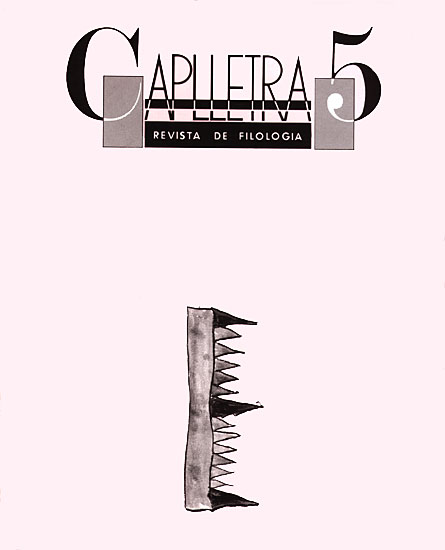|
–––––––– 129
–––––––– |

1. Josep Trench / A. Canellas: La cultura dels escribes i notaris de la Corona d’Aragó (1344-1479)
This paper reviews the work of the secretaries and scribes of the Royal Catalan-Aragonese Chancellory, from the time of Peter the Ceremonious to that of Ferdinand of Aragon. It provides brief biobibliographic information that identifies the beginnings of so-called Catalan-Aragonese Humanism, which cannot be dated before the late 14th century.
2. Vicent Martínez: Una entesa ben interessada entre la realitat i la fantasia: Blandín de Cornualla
This paper analyzes the relationships between reality and fantasy in Blandín de Cornualla as a precedent to a new esthetic conception of narrative prose and possibly of a new genre.
3. Josep Massot i Muntaner: La poesia popular i la Renaixença
From the second third of the 19th century onward, interest in anonymous oral literature grew in Catalan-speaking lands, which led people to collect, study, and imitate it.
4. Albert G. Hauf: La seducció de Gentil en el “Canigó” de Verdaguer i el romanç de “El infante Arnaldos”
According to Joan Fuster, the Canigó by Jacint Verdaguer is a medieval work in spirit, and totally rooted in old folkloric traditions. This article tries to prove that this is indeed the case by relating Verdaguer’s work to the medieval lore on fairies, and to the motif of mortals who are captives in fairyland. It further attempts to show how Verdaguer’s over-explaining of traditional symbolism could be very useful as a key to the poetic interpretation of more difficult texts such as, for instance, the splendid “romance” of the “infante Arnaldos”.
5. Joan-Rafel Ramos i Alfajarín: El valencianisme a Castelló en el segon decenni del segle XX
This paper presents an overall view of the reaffirmation of Catalan and of the orthographic and onomastic problems based on the cultural magazines which appeared in Castelló between 1910 and 1919. The role of La Veu de Castelló and of Gaetà Huguet Breva’s work is particularly noteworthy.
6. Santi Cortés / Anna Catalunya: Poesia franquista valenciana (1939-1943)
This paper analyzes the Francoist poetry written in Catalan that was published in Valencia between 1939 and 1943, when the dominant ideology was fascist. A collection of poems appears in the appendix.
|
–––––––– 130
–––––––– |
7. J. Gavaldà Roca: Un futurisme romàntic: Les metallengües de l’avantguarda catalana
This paper reflects on one type of poetry within the Catalan avant-garde tradition. The author analyzes the keys to Salvat-Papasseit’s futurism, paying particular attention to his position on the tradition/modernity opposition.